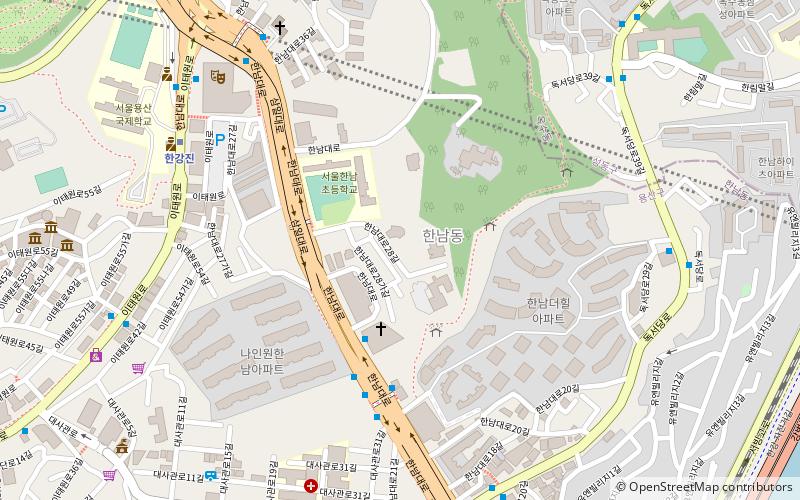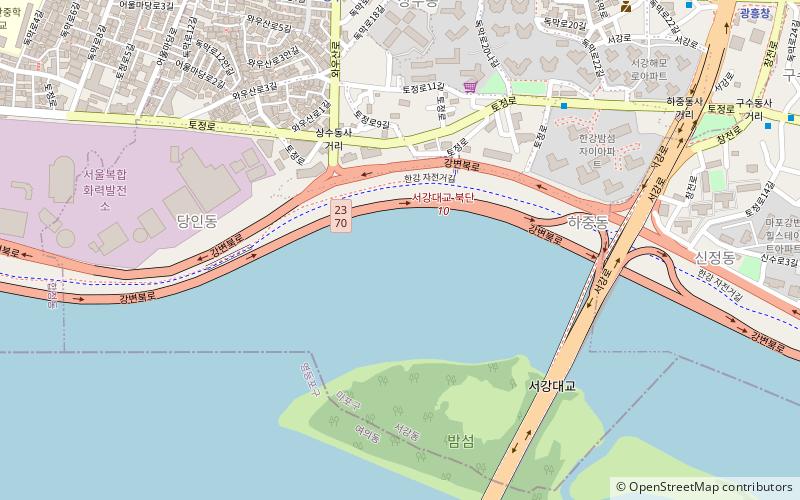Seoul: Neighbourhood
Places and attractions in the Neighbourhood category
Categories
- Museum
- Neighbourhood
- Art museum
- Park
- Bridge
- History museum
- Universities and schools
- Specialty museum
- Shopping
- Historical place
- Buddhist architecture
- Temple
- Church
- Vernacular architecture
- Market
- Skyscraper
- Mountain
- Theater
- Sport
- Sport venue
- Natural attraction
- Nature
- Library
- Art gallery
- Sacred and religious sites
- Concerts and shows
- City gate
- Unesco
- Fashion museum
- Palace
- Monuments and statues
- Arenas and stadiums
- Archaeological site
- City
- Concert hall
- Nightlife
Seobinggo-dong
Seobinggo-dong is a dong, neighbourhood of Yongsan-gu in Seoul, South Korea. It is directly across the river from Banpo-dong, Seocho-gu, with the Banpo Bridge connecting the two neighbourhoods.
Samseong-dong
Samseong-Dong is an affluent neighborhood or ward of Gangnam-gu in Seoul, South Korea. The area has a large concentration of upscale shopping malls, popular restaurants and hotels such as the Ramada Seoul Hotel and the Hyatt Park Hotel.
Hannam-dong
Hannam-dong is a dong, neighbourhood of Yongsan-gu in Seoul, South Korea. Initially not included within the Yongsan ward, during the Japanese colonial period it was a small hamlet called Han River Village within the Hanji township, Goyang County and lying close to the Han River.
Hapjeong-dong
Hapjeong-dong is a dong, neighbourhood of the Mapo-gu district in Seoul, South Korea.
Sinsa-dong
Sinsa-dong is a ward of Gangnam-gu in Seoul, South Korea. This district contains many department stores, hairshops, churches, boutiques, cafes and restaurants.
Seongbuk-dong
Seongbuk-dong is a dong, neighbourhood of Seongbuk-gu in Seoul, South Korea. Seongbuk-dong is a village located in the north of Seoul, nestled in the hills overlooking the city. A large proportion of the residences are owned by wealthy households. It is also where many ambassadorial residences are located.
Ihwa Mural Village
Ihwa Mural Village, is an area of Ihwa-dong, Seoul near Naksan Park that was revitalized by the Ministry of Culture, Sports and Tourism's public art "Ihwa-dong Naksan Project" in 2006, with paintings and installation art of about 70 artists.
Seocho-dong
Seocho-dong is a dong, or neighborhood of the greater Gangnam area Seocho-gu district of the South Korean city of Seoul. Seocho-dong is divided into 4 different dong which are Seocho 1-dong, 2-dong, 3-dong and 4-dong. The main street is Teheranno.
Sindorim-dong
Sindorim-dong is a dong, neighbourhood of Guro-gu in Seoul, South Korea. Sindorim-dong is the main transportation point where the Gyeongin-ro and western highway are interlocked with Sindorim Station, the transfer station for Seoul subway lines No. 1 and 2.
Bukchon Hanok Village
Heritage village with 600-year history Bukchon Hanok Village is a Korean traditional village in Seoul with a long history located on the top of a hill between Gyeongbok Palace, Changdeok Palace and Jongmyo Royal Shrine. The traditional village is composed of many alleys, hanok and is preserved to show a 600-year-old urban environment.
Cheongdam-dong
Cheongdam-dong is a ward of Gangnam District in Seoul, South Korea. The area is best known in South Korea as an affluent neighborhood populated by a disproportionately high number of high-income individuals and for having some of the most expensive real estate in the country.
Yeongdeungpo-dong
Yeongdeungpo-dong is a dong, neighbourhood of Yeongdeungpo-gu in Seoul, South Korea.
Pyeongchang-dong
Pyeongchang-dong is a dong, neighbourhood of Jongno-gu in Seoul, South Korea. Sometimes called the "Beverly Hills" of Seoul, due to it being a preferred residential location for Korean celebrities, it still remains a common location used in Korean films and television.
Myeong-dong
Myeongdong is a dong in Jung-gu, Seoul, South Korea between Chungmu-ro, Eulji-ro, and Namdaemun-ro. It covers 0.99km² with a population of 3,409 and is mostly a commercial area, being one of Seoul's main shopping, parade route and tourism districts.
Seogang-dong
Seogang-dong is a legal dong, neighbourhood of the Mapo-gu district in Seoul, South Korea.
Apgujeong-dong
Apgujeong-dong is a ward of Gangnam-gu in Seoul, South Korea. It is considered one of the wealthiest neighborhoods in South Korea.
Jangchung-dong
Jangchung-dong is a dong, neighbourhood of Jung-gu in Seoul, South Korea.
Daechi-dong
Daechi-dong is an affluent neighborhood in Gangnam-gu, Seoul, South Korea. Daechi-dong is divided into three different “dongs” which are Daechi 1-dong, 2-dong, and 4-dong. Daechi-dong is predominately considered the residential area of Gangnam.
Wonhyoro-dong
Wonhyoro-dong is a dong, neighbourhood of Yongsan-gu in Seoul, South Korea.
Cheongpa-dong
Cheongpa-dong is a dong, neighbourhood of Yongsan-gu in Seoul, South Korea.
Hangangno-dong
Hangangno-dong is a dong, neighbourhood of Yongsan-gu in Seoul, South Korea.
Majang-dong
Majang-dong is a dong, or neighbourhood of Seongdong-gu in Seoul, South Korea.
Samseon-dong
Samseon-dong is a dong, neighbourhood of Seongbuk-gu in Seoul, South Korea.
Chunghyeon-dong
Chunghyeon-dong is a dong, neighbourhood of Seodaemun-gu in Seoul, South Korea.
Garak-dong
Garak-dong is a neighbourhood, dong of Songpa-gu, Seoul, South Korea. The exact etymology is unknown but said that the town was once called garakgol.
Gwangjang-dong
Gwangjang-dong is a dong, neighbourhood of Gwangjin-gu in Seoul, South Korea.
Dongseon-dong
Dongseon-dong is a dong in seongbuk-gu, neighbourhood of Nowon-gu in Seoul, South Korea.
Daeheung-dong
Daeheung-dong is a dong, neighbourhood of the Mapo-gu district in Seoul, South Korea.
Mullae-dong
Mullae-dong is a dong of Yeongdeungpo-gu in Seoul, South Korea. The name "Mullae" comes from the neighborhood's old name, "Moraet-mal," which means "Sandy Village" in Korean. The neighborhood is most well known for its industrial factories.
Nokbeon-dong
Nokbeon-dong is a dong, neighbourhood of Eunpyeong-gu in Seoul, South Korea.
Jamsil-dong
Jamsil-dong is a neighbourhood, dong, of Songpa-gu, Seoul, South Korea. Its name is derived from silkworm breeding during the Joseon dynasty. Jamsil translates to a room or place for sericulture. The state encouraged people to raise silkworms, so founded Dongjamsil in the east vicinity of Seoul.
Map













































